|
|
 |
==Met Museum timeline: *South Asia, 1600-1800* |
 |
==Dozens of maps-- A great
many interesting maps from this period are available: *Columbia Univ.*. |
 |
==the British East India Company
gets a charter from Queen Elizabeth (1600) for trade
with South and East Asia. In 1641 the East India Company
sets up "factories" (=warehouses) at Madras. By now, has
"globalization" begun? Discussion: *wikipedia*; *John Richards*; *Imperial Gazetteer*; *W. W. Hunter*.
|
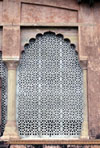 |
==Mughal influence in Bengal
(1600's) becomes more pervasive and complex. Political
and religious loyalties to the Mughal empire are by now
more thoroughly integrated into local cultural patterns.
Akbar's policy of religious tolerance is carried out in
practice as well as theory: consider Fr. Manrique's
story of his servants and the charges of peacock-murder,
in Chapter 7 of *Richard Eaton's book*. |
 |
==Jahangir (r.1605-27): On
Akbar's death, his son Jahangir (whose mother is a
Rajput princess, making him half-Rajput) takes the
throne. After a rebellious youth, he settles down to a
relatively quiet reign. In 1606 he marries the forceful
Nur Jahan. She and her father Itimad ud-Daulah become
major powers behind the throne; on her father's death,
she builds him a magnificent tomb (*IGNCA*;
*Berger*; *ANU*; *art and architecture*). Jahangir
composes the "Jahangir Namah," a wonderful
memoir in the family tradition, and has it illustrated
by his superb court painters. He also oversees the
(re)design and construction of Akbar's tomb at Sikandara
(*IGNCA*; *Berger*; *ANU*; *DSAL*; *archnet*; *art and architecture*).
Discussion: *Ikram Ch. 14*; *wikipedia*. (*Routes*) |
 |
==Sir Thomas Roe at the
Mughal court (1615-19): Sent as ambassador by James I,
he obtains (618) a "farman" from Prince Khurram (the
future Shah Jahan), the governor of Gujarat, which gives
"reasonable facilities for trade," but does not allow "a
building to be bought or built as permanent residence."
Jahangir sends a polite letter to James I: *Internet Sourcebook*. (*Routes*) |
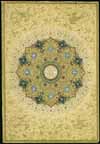 |
==Shah Jahan (r.1627-56): On
Jahangir's death, his son Shah Jahan (whose mother is a
Rajput princess, thus making him 3/4 Rajput) becomes the
great architect of the dynasty; the Peacock Throne is
his design. He doesn't quite conquer the Deccan, and he
has even worse luck with his Central Asian plans; it can
also be said that he does a poor job managing his four
ambitious sons. But who can quarrel with his taste in
art? Discussion: *islamic art*. Shah Jahan's picture
album, the "Padshahnamah": *Univ. of Penn.*; another lovely
album: *British Library*. Discussion: *Ikram
Ch. 14*; *wikipedia*. (*Routes*) |
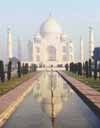 |
==the Taj Mahal and the Agra Fort:
In 1631 Mumtaz Mahal, Shah Jahan's beloved queen, dies
giving birth to her fourteenth child. Shah Jahan, almost
inconsolable, begins construction of her tomb, the Taj
Mahal. Image sources: *IGNCA* (with discussion); *Berger*; *ANU*; *DSAL*; and everybody who ever went
to Agra with a camera (*BBC*); try this *google search* and see for
yourself. Overshadowed but equally magnificent is the
Agra Fort nearby, which Shah Jahan expands far beyond
Akbar's initial work: *IGNCA*
(with discussion); *Berger*; *ANU*; *Phil G.*. General overview: *Havell on Agra*. (*Routes*) |
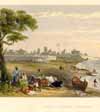 |
==Fort Saint George is
founded (1640): The future Madras, the first significant
fortified position held by the English, has a strong
mercantile and international flavor from the beginning.
In 1653 it becomes a Presidency. Discussion: *Imperial Gazetteer*. (*Routes*) |
 |
==Sir Thomas Browne, in a
thoughtful discussion of Pigmies (1646), concludes
that one must doubt the reliability of reports that
there are Pigmies "about Ganges in Asia": *Univ. of Chicago*. |
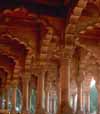 |
==Shahjahanabad, another Delhi:
"In 1648 Shah Jahan moves his capital from Agra to Delhi
and establishes a new fort called Shahjahanabad. This
palace city, measuring 5 million square feet, contains
royal apartments, harems, a secretariat, military
barracks, a treasury, a mint, and housing for thousands
of slaves, servants, and courtiers" (--Met). Images from *Berger*; *ANU*; from Archnet: *Jam'a Masjid*; *Red Fort*; *Divan-e 'Am*; *Khas Mahal*; *Naqqar Khanah*. (*Routes*) |
 |
==Dara Shikoh (1615-59),
Shah Jahan's oldest and favorite son, is by temperament
a mystic and scholar of mysticism. He translates fifty
Upanishads into Persian, and not only studies with Sufis
but also holds discussions with Hindus about Vedanta.
His work "Majma' al-Bahrain" (Confluence of the Two
Ocens) is of considerable intellectual interest (*AAS*). Unfortunately, he is not
cut out to be a military tactician, nor is he a good
judge of men; Bernier's account of his death: *Columbia Univ.*. |
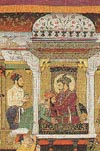 |
==Aurangzeb (r.1658-1707),
third son of Shah Jahan, is victorious in the vicious
four-way succession struggle. He seizes the throne and
places his father under house arrest in Agra Fort until
his death (1666); he executes all three of his brothers,
including Dara Shikoh. He lives a personally austere
life, and tries to rule in an orthodox Muslim way; this
causes him many problems with taxation and in other
areas. Still, he ends up with more Hindus among his
officers than any of his predecessors had had. He spends
the last twenty years of his life in the Deccan, trying
vainly to defeat the Marathas once and for all.
Discussion: *Ikram Ch. 15*; *wikipedia*. (*Routes*) |
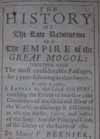 |
==Francois Bernier, a
French physician with entree into the Mughal court
(1656-68), provides a gripping eyewitness account (1671)
of the whole succession struggle and many of the events
surrounding it. In Bernier's opinion, despite
Aurangzeb's cruelties to his brothers, he is "endowed
with a versatile and rare genius" and is a "consummate
statesman, and a great King." Bernier's work: *Columbia
Univ.* |
 |
==Tavernier's travels:
Jean-Baptiste Tavernier (1605-89), the best-known
traveler of the century, publishes in 1676 his
multivolume "Travels," a uniquely comprehensive and
fascinating tour guide to late Mughal India, meant
especially for those who might want to follow in his
footsteps as a dealer in fabrics, rarities, and fine
jewels. He is a friend and cordial rival of Bernier's,
lacking his political subtlety but far more widely and
vividly descriptive: *Columbia Univ.* |
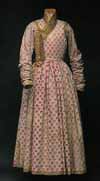 |
==Aurangzeb and "the communalization of
history" (*Manas*): Aurangzeb has
become a polarizing figure, and is used as a symbol of
intolerance in many modern debates. What kind of common
culture existed? See *Alam and Subramanyam* for an
illustration. Did Muslim rulers convert Hindus to Islam
by the sword? See Chapter 5 of *Richard Eaton's book* for an
overview of this and other theories. Did Muslim rulers
destroy thousands of Hindu temples? See Eaton's two
thoroughly researched articles on the subject: *one*; *two*. Was there a pre-Islamic
Hindu "golden age"? Here's a thoughtful analysis by
Sanjay Subramanyam: *Outlook* or *CU*. Aurangzeb becomes the hero of
*a tragedy by Dryden*, and father
of the imaginary princess *Lalla Rookh*. |
 |
==Sarmad, a convert to
Sufism from an Armenian Jewish family in Iran, arrives
in Sind around 1631 and soon becomes (in)famous for his
passionate love of a Hindu boy named Abhay Chand; he
wanders naked in the streets, reciting Persian poetry. A
defender of Dara Shikoh's, he is executed by Aurangzeb
around 1661/2. Discussion: *crda* (and some of his *quatrains*). |
 |
==Shivaji and the Marathas: Shivaji
(c.1627-80), leader of a Maratha clan, is such a capable
and effective warrior and guerrilla raider that he and
his family and clan come to pose a serious, ongoing
threat to Mughal power. For much of the eighteenth
century the Maratha Confederacy remains an important
military/political presence in both North and South
India, until finally defeated by the British (*MSSU*). Discussion: *Manas*; *Imperial Gazetteer*. Shivaji's
early raids are described by Bernier: *Columbia Univ.*. Nowadays
Shivaji's name is often exploited politically: *Dilip Chitre*; *Piyush Mathur*. (*Routes*) |
 |
==Rajasthani painting develops
(c.1660) Aurangzeb's austerity causes his court
musicians and many of his painters to seek new patronage
opportunities at Rajasthani courts like Udaipur; a new
Rajput school of painting also emerges at Basohli in the
Punjab Hills. The fall of Bijapur in 1686 (and Golconda
the following year) to Aurangzeb, and the travels of his
Rajput generals, cause another wave of artistic
influences to reach outlying courts. |
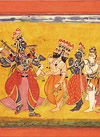 |
==Goddess worship and tantra become
more widespread as religious movements; their increasing
prevalence is reflected in painting as well (*Sackler*). Tantra in particular
has a long but marginalized history (*G. Thursby*). There are also
tantric movements in Jainism and Buddhism; and goddess
worship remains widely popular today (*Philip Lutgendorf*). (*Routes*) |
 |
==the French (in
Pondicherry, 1673-1954): The French too acquire a
colonial presence that lasts for several centuries. They
provide a particularly fine array of maps and views of
the early colonial port towns and fortresses. More
information: *Imperial Gazetteer*. (*Routes*) |
 |
==Guru Gobind Singh and a
new framework for Sikhism (1675–1708): The tenth and
last Guru, Gobind Singh, becomes embroiled in a
political conflict with Aurangzeb, and reorganizes the
Sikh community (*SGPC*). Members of the "Khalsa"
(Pure) are to give up their caste names, with men using
"Singh" (Lion) and women "Kaur" (Princess). Male Sikhs
are never to go without the five kakkars ("k" items):
kangah (wooden comb), kirpan (dagger), kara (steel
bracelet), kachch (shorts), and kesh (uncut hair). Guru
Gobind Singh also compiles the Guru Granth Sahib (*sacred texts*), the Sikh
scripture, which will be the Guru after his death. |
 |
==Calcutta is founded by Job
Charnock in 1690, as the *Imperial Gazetteer* confidently
asserts. Or maybe not, as the *Tribune India* firmly reports.
Anyway, Job Charnock is wandering around there at that
time, doing something. He's buried there, too. (*Routes*) |
|
|
























